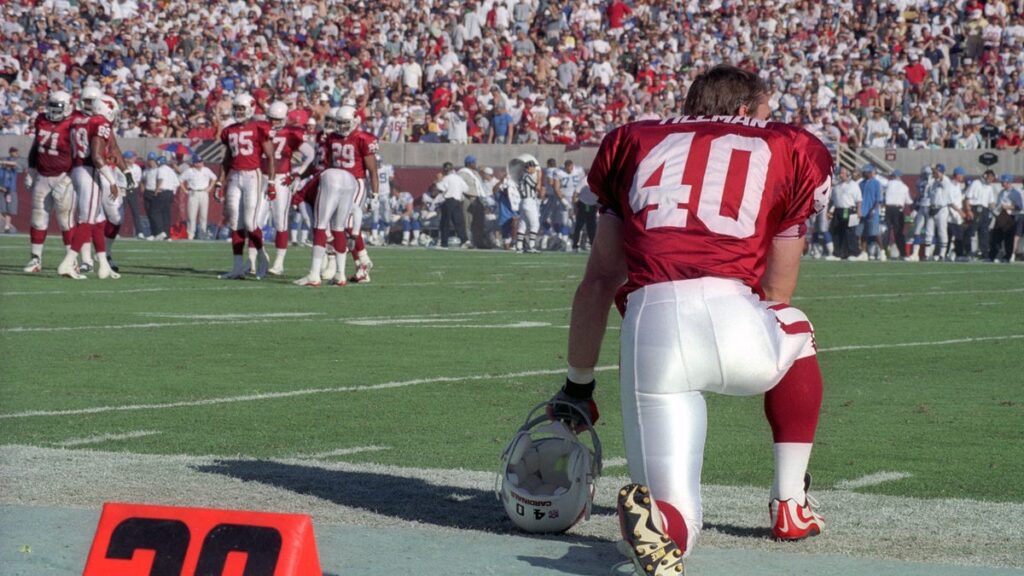Zack Walz recalls his hero of a teammate
Pat Tillman’s name is always embedded in the minds of the people of Arizona, but in April, it’s especially poignant.
It was on April 19, 1998, that the Arizona State standout was selected by the Arizona Cardinals in the seventh round of the draft, 226 overall.
It was on April 22, 2004, that Tillman was tragically slain by friendly fire in Afghanistan.
And it’s around those dates every year since 2005 that Pat’s Run takes place to benefit the Pat Tillman Foundation, which now has close to 1,000 Tillman Scholars making differences in people’s lives.
One of those is coincidentally April Krowell, an Army veteran with a PhD in psychology from Ball State, who spent time in Iraq and now specializes in the neuropsychological and psychological assessment of adults and older adults with a wide variety of neurological disorders, medical diagnoses, and psychiatric conditions.
When asked how life-changing being a Tillman Scholar has been, she says simply, “100 percent.”
That number would be an apt way to describe Tillman in every aspect of his life in and beyond football.
This year’s run was on April 12 filling the streets of Tempe with more than 30,000 runners and walkers, and the night before at a welcome VIP event inside Mountain America Stadium, teammate Zack Walz reflected on the man Tillman was and what it was like to be around him.
A linebacker from Dartmouth, Walz was picked one round before him with the 158th overall choice in that ’98 draft and he jokes (maybe) that it was an example of the team’s poor personnel evaluations.
He and Tillman played high school football in northern California and were opponents in a senior-year all-star game.
Walz said it was immediately apparent how special Tillman was. He said, “Pat set himself as a leader on that team in the first two weeks of our rookie training camp. That was undeniable. Everybody saw that. He was this intellectual leader. He’s just tough as nails. He doesn’t take (expletive) from anybody, right? But he’s so likable and lovable. And he’s always challenging the people around him to do better.
“Even the coaches. He’d argue with (defensive backs coach) Larry Marmie all the time. ‘Larry, shouldn’t we do this?’ And I know the coaches love him, right? They know this guy’s so invested that he’s actually challenging him.”
The stories always come in cascades from people that knew Tillman and were close to him.
Walz recalled, “He would come in after a two-hour practice, 115 degrees. We’d all be icing, getting ready for lunch and our meeting and going home. And we had this water tank with a treadmill in it. And it was up to your knees and it shoots jets at you. And it’s like resistance running in water. It’s harder than running outside. He would come in from practice and I’d see him in there an hour and half into lunch.”
Asked what he was doing, Walz said Tillman answered, “I’m running a marathon as soon as the season ends. He was already working towards that. Those are the things that were unheard of. You didn’t see that in people. I look at my experience; I tell my mom this all the time: I truly believe God’s purpose for me was to be around him while his life unfolded so I could watch and I could learn.”
It’s almost eerie that the duo’s NFL careers both ended after the 2001 season when Tillman enlisted in the Army and Walz never played another down.
He said there was an epiphany when Tillman told him of his decision not long after 9/11.
“I will tell you, I was so hung up in the dollars and cents of where am I going to sign,” Walz said. “Where am going to make my next million dollars? But I was so hung up on, am I going to sign? And when he called me and told me that, I remember my life, it came with such a calm, and things were instantly forced into perspective. Of course I still wanted to play football, but it was just like, my motivation to do it wasn’t the same.
“Because I just felt there was so much else I could accomplish. The thing is, you’re doing something and then you watch him doing it and you realize the way he’s doing it typically was always better. And I say he was this indirect teacher where just watching him interact with, navigate people.”
Walz said there was something singular about that.
“He was always more interested in learning about you,” Walz said. “People were waiting to talk to him and ask him questions. And he’d be like, no, we’re not talking about me. Tell me what you do. I had a friend who was a plumber, and Pat talked to him for 30 minutes. And he’s asking about all these things he’s got going on. And he was trying to close some big contract. The next time Pat saw him, or that my friend saw Pat, was a year later.
“Pat went up to him and literally asked him how that deal went. He remembered. Those were the little details that he took from everybody. He was a genuine listener. He cared about people. He took something from everybody. And he was relatable, approachable. He always put himself on the same, I don’t want to say playing field, but the same level. And that’s just an art, right? Nowadays everybody’s got cameras, right?
“You always question when somebody’s doing something, are they doing it because they know they’re on camera somewhere? Back then, there were no cameras. And Pat was doing these things when nobody was looking. He wasn’t doing it for fanfare, he wasn’t doing it for a conversation for people to say, ‘Oh, he does this.’
“That’s the way he was. That’s what he embodied.”
Walz is non-stop talking about his friend.
Reflecting on playing in the NFL, even if it was only four years, he said, “For all of us, it was like the pinnacle of our achievement. That’s where my career ended. For him, it was just a stepping stone to do something higher and greater. And that’s how he carried himself. Yes, he took it very seriously and he worked harder than most people I’ve seen working. He always had a chip on his shoulder. He was such an intellectual. He was a consummate learner. But it was like, that was not the end-all.
“And that’s really what you come to appreciate with him. And it is important to carry on his story. When you talk about carrying the message on to our younger generations, I think parents, if they’re not telling their children who he was and what he stood for and what he embodied, they’re doing their kids a disservice.”
“He was a man of action. He was a man of example. And you think about all those little stories and the things that he was doing when nobody was looking. That’s what made him great … among a million other things.”
Walz goes to another level after being told about the mosaic at the Pro Football Hall of Fame that has about 500 football cards of Hall of Famers and … one of Pat Tillman that the Hall decided to keep in the display because of what he represented.
Noting that Tillman was just coming into his own after four seasons, Walz said, “He didn’t have the speed of a natural starting NFL safety, but that guy outworked everybody. He played with a bigger chip on his shoulder than anybody. If he had played another four years, he’d be a perennial All-Pro. And I believe that. He was starting to turn the culture of our organization. Imagine if he played another five years. I mean he could have played 15 years for sure. No question about it.
“The intellect is undeniable. And then you put all that together with a little bit of extra experience. The guy would have been a legendary safety.”
However, Walz understands there was more to Pat Tillman. Infinitely more.
He said, “But then you think about that guy and it just wouldn’t fulfill him. It just wouldn’t fulfill him. And I think about it like I missed out on it. But again, then you think at the end of the day, that’s me. That’s my dreams. That wasn’t his. His were much loftier. And I want to just say: more service to the greater good.”
Get more Cardinals and NFL coverage from Cards Wire’s Jess Root and others by listening to the latest on the Rise Up, See Red podcast. Subscribe on Spotify, YouTube or Apple podcasts.
#Arizona #Cardinals #teammate #reflects #legacy


